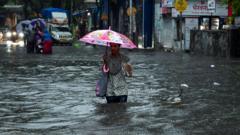Heavy rains last month wreaked havoc across India's financial capital, Mumbai, as thousands of residents found themselves stranded and frustrated due to widespread flooding, even before the monsoon season fully commenced. Each heavy downpour turned roads into rivers, halted transportation, and inundated low-lying neighborhoods, with the city's infrastructure once again under scrutiny, especially when a newly-built underground metro station was submerged in floodwaters.
The Brihanmumbai Municipal Corporation (BMC), responsible for maintaining the city's infrastructure, faced backlash for initially attributing the flooding to clogged drains and debris from construction sites. In response to criticism, BMC deployed de-watering pumps in prone areas and intensified drainage clearing efforts, but residents claimed these measures were implemented too late.
This flooding crisis is not unique to Mumbai; major cities from Delhi to Bengaluru experience similar issues every monsoon season. Experts attribute the persistent flooding to rapid, unplanned urban growth coupled with aging infrastructure and environmental neglect. "The pace of urban expansion has far exceeded the evolution of supporting infrastructure, particularly in water and drainage systems," says urban planner Dikshu Kukreja.
India’s monsoon rains account for 80% of the annual rainfall, a vital resource for millions of farmers relying on seasonal precipitation. However, climate change is exacerbating erratic weather, leading to unseasonal rains, flash floods, and droughts. The current monsoon arrived earlier than expected, catching many authorities off guard.
Delhi, notorious for its urban flooding, recorded its wettest May since 1901, leading to property damage and casualties. Meanwhile, Bengaluru has seen its natural lakes, which helped manage excess rainwater, encroached upon, leading to an increased vulnerability to floods. Activist Ram Prasad emphasizes the need to respect water bodies to safeguard the city from flooding.
Mumbai faces unique challenges due to low-lying geography and proximity to the sea, with natural barriers like mangroves diminished by urban development. Experts agree that the systemic breakdown is rooted in poor planning and weak regulatory enforcement, leading to reactive governance.
The flooding crisis affects smaller towns as well, with recent devastating floods in northeastern India resulting in numerous fatalities and significant displacement. Addressing these chronic flooding issues will require a long-term strategy that combines technology, community involvement, and responsive governance.
To fortify India's cities against future monsoons, experts recommend proactive planning that utilizes predictive models and real-time data to identify at-risk areas. It's crucial for urban planners and authorities to prioritize sustainable infrastructure development in order to mitigate the damage inflicted by the annual monsoon deluge.
The Brihanmumbai Municipal Corporation (BMC), responsible for maintaining the city's infrastructure, faced backlash for initially attributing the flooding to clogged drains and debris from construction sites. In response to criticism, BMC deployed de-watering pumps in prone areas and intensified drainage clearing efforts, but residents claimed these measures were implemented too late.
This flooding crisis is not unique to Mumbai; major cities from Delhi to Bengaluru experience similar issues every monsoon season. Experts attribute the persistent flooding to rapid, unplanned urban growth coupled with aging infrastructure and environmental neglect. "The pace of urban expansion has far exceeded the evolution of supporting infrastructure, particularly in water and drainage systems," says urban planner Dikshu Kukreja.
India’s monsoon rains account for 80% of the annual rainfall, a vital resource for millions of farmers relying on seasonal precipitation. However, climate change is exacerbating erratic weather, leading to unseasonal rains, flash floods, and droughts. The current monsoon arrived earlier than expected, catching many authorities off guard.
Delhi, notorious for its urban flooding, recorded its wettest May since 1901, leading to property damage and casualties. Meanwhile, Bengaluru has seen its natural lakes, which helped manage excess rainwater, encroached upon, leading to an increased vulnerability to floods. Activist Ram Prasad emphasizes the need to respect water bodies to safeguard the city from flooding.
Mumbai faces unique challenges due to low-lying geography and proximity to the sea, with natural barriers like mangroves diminished by urban development. Experts agree that the systemic breakdown is rooted in poor planning and weak regulatory enforcement, leading to reactive governance.
The flooding crisis affects smaller towns as well, with recent devastating floods in northeastern India resulting in numerous fatalities and significant displacement. Addressing these chronic flooding issues will require a long-term strategy that combines technology, community involvement, and responsive governance.
To fortify India's cities against future monsoons, experts recommend proactive planning that utilizes predictive models and real-time data to identify at-risk areas. It's crucial for urban planners and authorities to prioritize sustainable infrastructure development in order to mitigate the damage inflicted by the annual monsoon deluge.




















